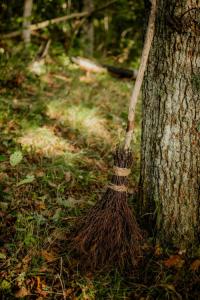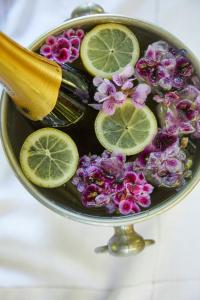Spring has always been a time of renewal, both physically and spiritually. In Appalachian folk magic, spring cleaning isn’t just about tidying up—it’s about clearing out old energy, protecting the home, and inviting blessings for the new season. This practice is deeply rooted in both European and Indigenous traditions, passed down through generations in the mountains. Since I’ve been diving into the practices of my ancestors, I thought it would be fun to share some of these traditions.
Spring Cleaning Begins with a Broom

Brooms are not only used for sweeping up dirt. People would normally start at the back of their home and sweep towards the front door to clear out both the dirt and negative energies. However, you would never use a new broom for this without first sweeping something in from the outside that would invite prosperity into the home. Some items you could use include cinnamon (for prosperity), salt (for vitality), and other herbs such as rosemary, bay leaves, lavender, and sage.
Once you have swept from the back of the house to the front and out the door, it is good luck to throw the contents of the dustpan over your left shoulder. This would ensure good luck and prosperity,
Herbal Washes for Body and the Home

Many Appalachian families made herbal washes to purify their homes, often using plants that grew wild in the mountains. If you want protection and renewal, a wash made with pine is good for this. Washing the floors with water, salt and vinegar is good for banishing negative energies. Cedar that is burned and made into a tea or for washing walls was said to be good at cleansing a house of sadness.
A common Appalachian house blessing involved mopping the floors with pine water and sprinkling a little salt at the doorways to protect the home from evil spirits.
As for cleansing the body, bathing in milk, honey, and herbs like lavender was believed to bring beauty and attract positive energy. Washing hands or feet in a flowing stream on the first day of spring was thought to remove illness and bad luck. Sassafras tea, dandelion greens, and poke salad were taken as “spring tonics” to cleanse the blood and promote vitality.
Fire and Smoke Protection

Burning cedar, pine resin, or tobacco was common, especially in spaces that felt spiritually heavy. Another thing to do would be to light a white candle in every room to drive out bad energy. Burning cedar, mugwort, pine resin, or tobacco was common, especially in spaces that felt spiritually heavy.
Some families built small fires outdoors in early spring and jumped over them for good luck, similar to European traditions tied to Beltane.
Final Blessings and Protection for the Season Ahead
Once the home was cleaned and the body was refreshed, the final step was ensuring blessings and protection lasted through the season. Some families would walk through the house reading from Psalms (especially Psalm 23 or 91) to invoke divine protection. One could also sprinkle salt or holy water around the perimeter of the house, as well as leaving a bit of milk or bread on the doorstep to thank the spirits for their protection.
A few other things that could be done are hanging an eggshell in the home to absorb negative energies and bad luck. Hammering an iron nail into the threshold or hanging a horseshoe over the door ensured protection. Rowan and Dogwood crosses were hung about the home to ward off malevolent spirits.
Which of these methods are you going to try? Do you have any that you would like to share? I’d love to hear from you in the comments.













